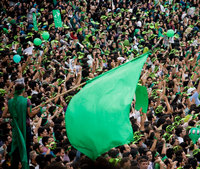Last week's much-anticipated Friday sermon by Akbar Hashemi Rafsanjani confirmed that the protests and resistance in Iran are no longer about the much-disputed June 12 presidential election. Despite post-election speculation on the prospects for a second Iranian revolution, the current situation more closely resembles a civil rights movement -- one emerging organically from within the framework of the country's constitution.
In many respects, this mirrors the choice that increasingly emerged for Iranian voters in the final weeks of the election campaign, between a more pragmatic and measured approach -- offered most visibly by Mir Hossein Moussavi -- and the almost paranoid strain of nationalism represented by incumbent President Mahmoud Ahmadinejad.
Noted Iranian scholar Reza Aslan has compared the choice to that between China and North Korea: a more open, but still-controlled society on the one hand, and a police state on the other. The comparison is accurate. But at present, Iran's supreme leader is in a state of paralysis, unwilling -- or unable -- to let the country move in either direction.

